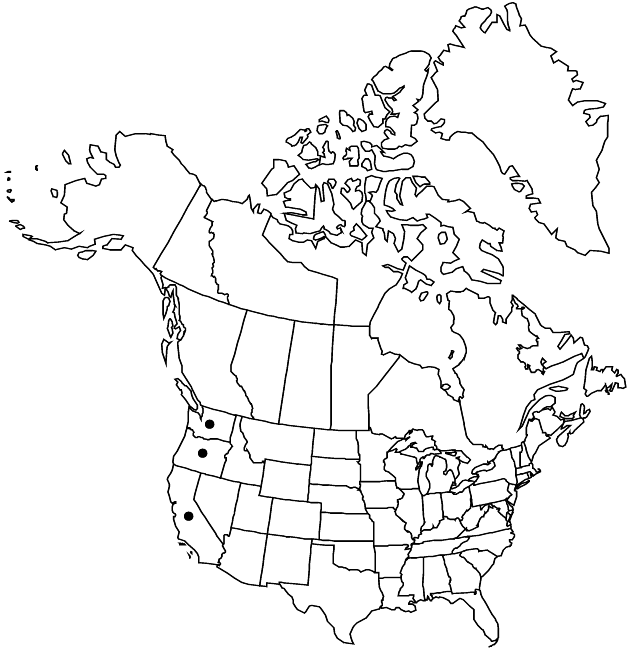Difference between revisions of "Heterotheca oregona"
Field & Lab. 19: 71. 1951.
imported>Volume Importer |
RevisionBot (talk | contribs) m (Bot: Adding category Revised Since Print) |
||
| Line 92: | Line 92: | ||
}}<!-- | }}<!-- | ||
| − | -->[[Category:Treatment]][[Category:Heterotheca]] | + | --> |
| + | |||
| + | [[Category:Treatment]] | ||
| + | [[Category:Heterotheca]] | ||
| + | [[Category:Revised Since Print]] | ||
Latest revision as of 18:20, 6 November 2020
Perennials, 15–105 cm; caudices branched. Stems ascending to erect (sometimes ± brittle, sometimes brown), glabrate to densely hispid or densely stipitate-andular (axillary leaf fascicles sometimes present). Leaves: basal and proximal cauline withering by flowering; sessile; mid and distal blades ovate to linear-lanceolate, 12–50 × 4–40 mm, rounded to very weakly clasping, margins flat, strigoso-ciliate, apices acute, faces glabrate to densely hairy and/or stipitate-glandular; branch leaves reduced. Heads (discoid) 1–15 per branch, in corymbiform, openly paniculiform, or racemiform arrays. Peduncles 5–50 mm, sparsely to densely hispid, stipitate-glandular; bracts linear to narrowly lanceolate, 3–9 × 0.5–2 mm. Involucres turbino-cylindric, 7.5–14 mm. Phyllaries in 5–7 series, outer ovate to deltate (2–5 × 0.6–1.7 mm), inner lanceolate, unequal, abaxial faces sparsely to densely hispid or stipitate-glandular (in green zone). Ray florets 0. Disc florets (14–)20–45(–60); corollas ± ampliate, (7.5–)8.5–11(–14) mm, throats and lobes sparsely short-pilose, lobes 0.4–0.9 mm (margins thickened). Cypselae monomorphic, obconic, compressed, 2–5 × 0.35–1.6 mm, ribs 5–10, faces sparsely strigose; pappi tan, outer of linear scales 0.1–0.5 mm (not obvious), inner of 30–40 bristles 4.5–6.4, longest weakly clavate. 2n = 18.
Distribution

Calif., Oreg., Wash.
Discussion
varieties 4 (4 in the flora
Varieties 4 (4 in the flora).
Selected References
None.
Lower Taxa
Key
| 1 | Distal stems densely, coarsely stipitate-glandular; mid cauline leaves averaging 13.9 × 3.9 mm (9.2–19.4 × 2.2–7.8 mm); outer phyllaries narrowly to broadly ovate; inner Coast Ranges, California | Heterotheca oregona var. scaberrima |
| 1 | Distal stems sparsely to moderately, coarsely stipitate-glandular, or moderately to densely, finely stipitate-glandular; mid cauline leaves averaging 22–32 × 4.7–9.1 mm (1.5–42.5 × 2.1–36.3 mm); outer phyllaries lanceolate; Cascades to Coastal ranges, Washington to c California | > 2 |
| 2 | Stems usually branched proximally; leaves gray-green, long-villous (200–1000+ m in moun-tains, n California) | Heterotheca oregona var. compacta |
| 2 | Stems usually openly branched distally; leaves green, glabrate to moderately hispid | > 3 |
| 3 | Stems moderately to densely, finely stipitate-glandular; branch leaves glabrate to sparsely hispid (fewer than 5 hairs/mm²), moderately stipitate-glandular; Olympic Peninsula and Cascades to Coastal ranges (n, c California) | Heterotheca oregona var. oregona |
| 3 | Stems sparsely to moderately coarsely stipitate-glandular; branch leaves moderately short-hispid (more than 5 hairs/mm²), sparsely to moderately, coarsely stipitate-glandular; coast to lower mountains, s Oregon, n California | Heterotheca oregona var. rudis |